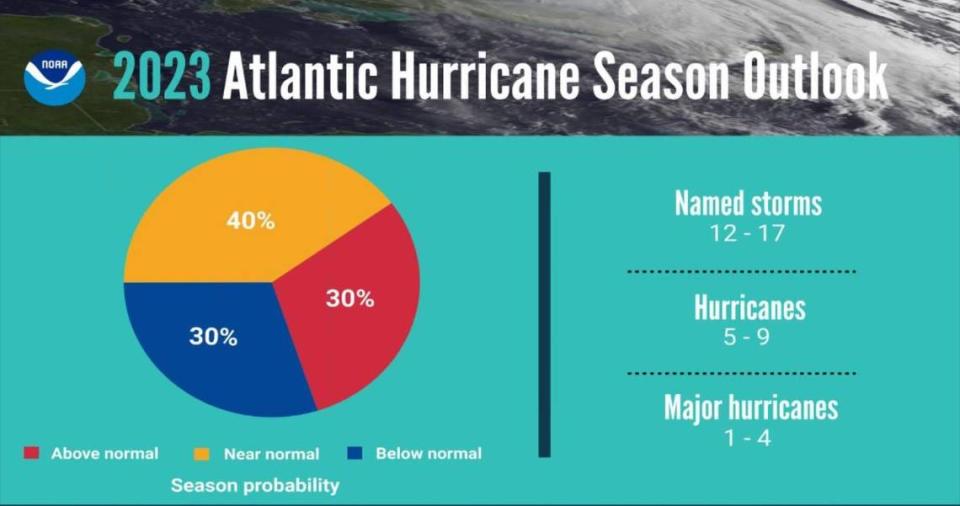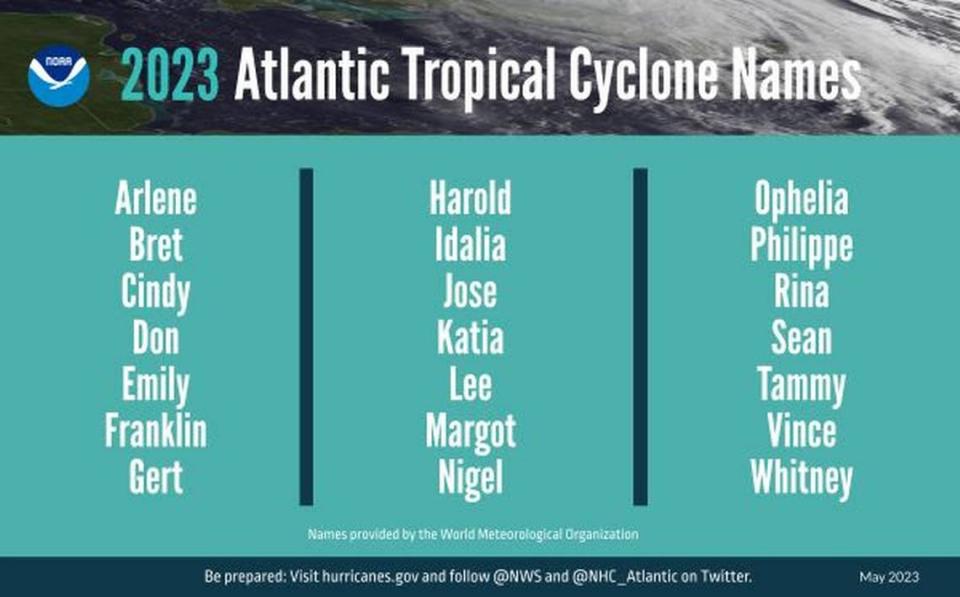What’s likely in store for hurricane season. We’ve got the details from NOAA
For the first time in several years, the 2023 hurricane season could be quieter than usual, with calls for a “near normal” season.
At a press conference Thursday, the National Oceanic and Atmospheric Administration released its official prediction for the upcoming hurricane season: 12 to 17 named storms, five to nine of which could develop into hurricanes and one to four that could strengthen into powerful Category 3 or stronger storms. The top end is Category 5.
The agency predicts there’s a 40% chance of a near-normal season and a 30% chance of either a below-average or above-average season.

Matthew Rosencrans, lead hurricane season outlook forecaster for NOAA’s Climate Prediction Center, said scientists made their prediction based on the combination of factors, some of which usually signal a quieter season and others that are usually associated with active hurricane seasons.
“It’s definitely kind of a rare setup for this year, which is why our probabilities are not 60 or 70%, to reflect that uncertainty,” he said. “When we looked at it we thought wow, there’s a lot of uncertainty in the outlook.”
Last year was considered a slightly above-average storm year, with 14 named storms, 8 hurricanes and two major hurricanes, including, infamously, Hurricane Ian. Category 5 Hurricane Ian slammed the Southwest coast of Florida in September, killing nearly 100 people, destroying thousands of homes and earning a spot in the record books as Florida’s most expensive storm to date.
Hurricane Ian hit Cat 5 in Gulf, was Florida’s most expensive storm. Official final numbers
Hurricane Nicole, which struck Florida’s northeast coast as a Category 1 in November, also walloped the state with more flooding rain and storm surge that chewed off pieces of the beach, leaving houses and condominium buildings perched on the brink of collapse.
El Niño versus very hot Atlantic
NOAA’s prediction hinges on the formation of an atmospheric phenomenon called El Niño, which warms waters in the Pacific Ocean and shifts upper-level winds in the Atlantic. That makes it more difficult for hurricanes to form and usually heralds a quieter season.
But relative calm in the Atlantic doesn’t come free. El Niño is also associated with a colder, wetter winter for other parts of the U.S., which could cause more intense snowstorms and flooding.
NOAA hasn’t officially declared that an El Niño has begun, but its latest update pegged the changes of a spring development at 90%.
Earlier predictions for this season heavily weighed the impact of a potential El Niño and called for an even quieter season, but in the last few months, some important factors have changed in the Atlantic Ocean, tipping NOAA’s forecast up to a “normal” season.
The Atlantic Ocean has gotten much hotter and the upper-level winds are now favorable to storm development, creating a friendly atmosphere for hurricane formation.
“It’s about the interplay between the El Niño and the favorable conditions across the Atlantic, not just the temperature but predicted shear patterns,” Rosencrans said. “El Niño can control about 33 to 38% of variants, so it’s not all of it.”

Hurricane season begins June 1 and runs until Nov. 30, with a usual peak in activity in August and September. The last few seasons have seen storms form ahead of that official start date, and this year is no exception.
The National Hurricane Center recently declared that a subtropical storm formed in mid-January off the northeast U.S. coast. The next storm to reach tropical depression status this year will be tropical depression two, or, if it strengthens into a tropical storm or hurricane, Arlene.
READ MORE: Hurricane season heats up earlier and earlier. New study suggests climate change is why
NOAA’s prediction is slightly more aggressive than several other early season forecasts, many of which called for below-average seasons. The agency updates its forecast in August, just before the peak of the hurricane season.
“The time to prepare is today; the time to prepare is now,” Deanne Criswell, FEMA’s administrator, said during the NOAA press conference.
Miami-Dade County Mayor Daniella Levine Cava also hosted a hurricane season press conference on Thursday. She urged residents to use the upcoming Memorial Day weekend to stock their hurricane kits and make a plan in case a storm does strike during the next six months.
“We all know too well that just one storm can cause a catastrophic impact, so we need to ensure we are as safe and prepared as possible,” she said.
Levine Cava warned all residents — especially newcomers — to stay updated before, during and after a storm on Miami-Dade’s website and social media channels, by calling 311 or downloading the Ready Miami-Dade app.
“Let’s be smart, let’s be prepared and let’s stay safe this hurricane season,” she said.
